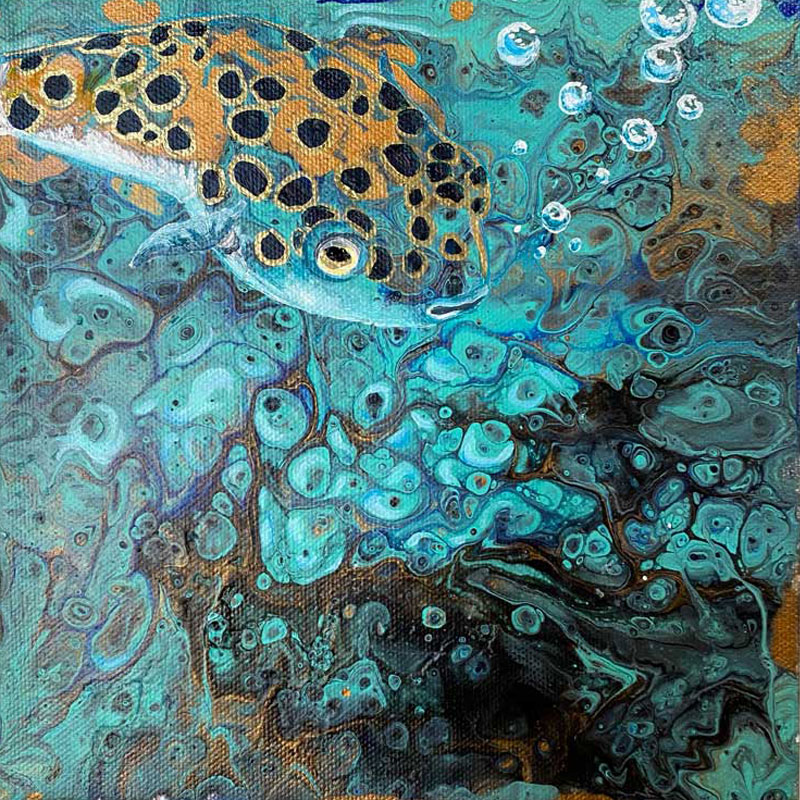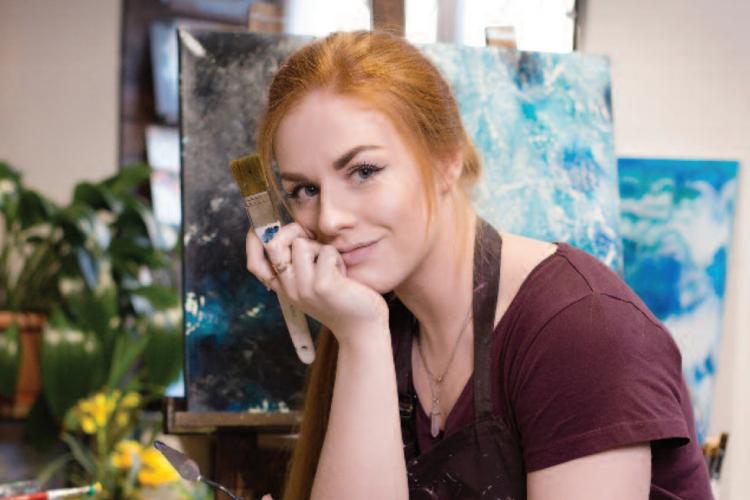Cover Story – The Therapeutic Value of the Arts
Beyond the medications and therapies, such as physical, occupational, and speech, which are a part of combatting the effects of autoimmune diseases including multiple sclerosis, there is a lesser acknowledged yet equally important component making its own impact: Art.
So often, when we think of “art,” we think of paintings and drawings… We think of our favorite bands and the musical instrument we played in elementary school… And we think of famous authors of literature toiling away over a notepad and pen or an old-fashioned typewriter.
Fortunately for all of us, that is only the tip of the proverbial iceberg. Art is our chance to express our creativity, to flex our imagination, and, in the words of Thomas Merton, an American Trappist monk, writer, theologian, and poet, “to find ourselves and lose ourselves at the same time.”
But beyond all of that, “art” in its many forms can also improve mental, and in some cases, physical health, as well.
How, you ask? Let’s take a closer look and find out…
Music

A peek at an online dictionary defines “music” as: “vocal or instrumental sounds (or both) combined in such a way as to produce beauty of form, harmony, and expression of emotion.” For a board certified music therapist like Betsy Hartman, MT-BC, NMT-Fellow at the Swedish Multiple Sclerosis Center in Seattle, it also allows for clinical intervention to help address speech, motor, and cognitive needs, as well as emotional and mental health.
“When the brain is not communicating to the body the way we want it to, music can step in as that bridge,” says Hartman. “For instance, if a patient has difficulty walking, I can use rhythm – a steady one-two-three-four tempo – to help them sync up to the beat, enabling them to walk more smoothly.”
Sometimes finding that bridge comes down to the use of a metronome. And sometimes, verbal prompts, notes on a piano, or a favorite song are used to help a therapist find the appropriate tempo – or time keeper, if you will – for a patient. This type of gait training is known as Rhythmic Auditory Stimulation.
“A simple song like ‘You Are My Sunshine’ can be what a patient needs to improve their gait. By listening to the song as they walk, the patient entrains to the tempo and cadence which, in turn, adds structure and stability to their walking pattern. From there, they can transition to humming the song as they walk – it becomes a musical support or crutch,” says Hartman. “Sometimes a patient can pick this technique up right away, but sometimes it comes with training.”
Gait isn’t the only physical skill for which music therapy has shown improvement in MS. Balance, muscle strength, and hand function can also be positively impacted.
Researchers Josiane Lopes and Ivo Ilvan Keppers conducted a systemic review of clinical trials related to music-based therapy in the rehabilitation of people with multiple sclerosis. They selected ten trials to review. Those ten trials sampled a total of 429 individuals with a total of 253 allocated to the experimental MBT (music-based therapy) group, and 176 to the control group (those on conventional therapies or no intervention at all). The music-based therapy areas of rhythmic auditory, playing musical instruments, dance strategy, and neurological music were all explored. Lopes and Keppers found that, overall, “the studies consistently showed that MBT was better than conventional therapy or no intervention, with regard to gait parameters, fatigue level, fatigability, emotional status, and pain.” This led to their conclusion that “MBT is a safe and effective approach for clinical rehabilitation of MS patients that leads to positive results regarding motor and non-motor functions.”
Still another intervention often used by music therapists focuses on psychosocial support. Therapy in this area might include listening to songs that make a person happy and, in turn, help with the motivation needed for therapy compliance.
A German article written by H Lengdobler and WR Kiessling (Psychother Psychosom Med Psychol, 1989) looked at group music therapy as a psychotherapeutic treatment. Over a two-year timeframe, 225 people with MS were given an opportunity to participate in music therapy group sessions following admission to an MS clinic. The data gleaned from those sessions suggest that the group sessions were “a useful adjunct not only in actual psychological support but also in individual coping strategies.”
 Another study, this one by D. Aldridge and colleagues, also looked at musical therapy in the treatment of those with multiple sclerosis. This pilot study included 14 women and six men who participated in eight-to-10 music therapy sessions over the course of a year. A summary of the findings published in Complementary Therapies in Medicine in 2005, said that “individuals who participated in music therapy demonstrated improved fatigue, mood, and self-acceptance.”
Another study, this one by D. Aldridge and colleagues, also looked at musical therapy in the treatment of those with multiple sclerosis. This pilot study included 14 women and six men who participated in eight-to-10 music therapy sessions over the course of a year. A summary of the findings published in Complementary Therapies in Medicine in 2005, said that “individuals who participated in music therapy demonstrated improved fatigue, mood, and self-acceptance.”
Depending on the goal for an individual, music therapy can entail listening to/playing instruments, singing, songwriting, and, as we already touched on, movement. Sessions are often in-person, but the pandemic and its need for virtual visits has really widened the reach.
Megumi Azekawa, MM, MT-BC Neurologic Music Therapist, Fellow, recently began a weekly program at the Swedish MS Center called “Singing in the Brain.” The goal of this singing-based exercise group is to promote vocal health and help improve speech and voice challenges in people with MS.
“I call singing the whole brain workout. It helps people with MS to restore, maintain, and improve emotional, physical, and physiological health and wellbeing,” Azekawa explains. “When we sing, we must breathe more deeply than when we talk. Therefore, singing helps you to send more oxygen to the brain which promotes better cognitive processing, motor control, and better mood and feeling.”
 Singing, Azekawa points out, also stimulates the areas of the brain involved in attention, memory, information processing, sequencing, organizing, and decision-making. In addition, “For people with MS who are experiencing speech and swallowing difficulty, singing and vocal exercises can be a good way to strengthen the muscles that are involved in swallowing and respiratory function.”
Singing, Azekawa points out, also stimulates the areas of the brain involved in attention, memory, information processing, sequencing, organizing, and decision-making. In addition, “For people with MS who are experiencing speech and swallowing difficulty, singing and vocal exercises can be a good way to strengthen the muscles that are involved in swallowing and respiratory function.”
Intrigued, but have never seen yourself as having any sort of musical ability? No worries.
“Our goal is to teach all people how to access the benefits of music to support physical and mental health. Our goal isn’t to make anyone a musician – although that can sometimes be an added bonus,” Hartman says. “Think about it this way, just like people aren’t required to be athletes to participate in physical therapy, people aren’t required to be musicians to participate in music therapy.”
Cathy Lykes has been participating in music therapy sessions for nearly five years and she is a big believer in its many benefits. Physically, she enjoys the opportunity to use muscles she might not normally use. Emotionally, she appreciates the lift it brings her on a not-so-good day. And socially, she enjoys the opportunities it provides to connect with others who understand the MS journey.
“If I’m having a bad day, I know that if I can connect with a class, my day will go better,” Lykes says. The class she takes, led by Hartman, offers something for everyone – an aspect Lykes enjoys.
“Betsy [Hartman] uses a wide variety of instruments depending on each person’s ability. Drums, xylophones, bells, whistles, and even scarves for movement are used. And some people simply sit and listen to the music and that’s okay.”
 The key, Lykes says, is to not be intimidated by the word “music.”
The key, Lykes says, is to not be intimidated by the word “music.”
“Music therapy has done so much for me,” Lykes says. “You don’t have to know how to play an instrument or sing a song. None of that is necessary. Just give it a try. I always feel better and less stressed when I attend a session.”
As for how people with MS can go about exploring the possibility of music therapy for themselves, Hartman reminds people of the importance of always advocating for oneself. She recommends talking to your healthcare provider, physical therapist, or occupational therapist, to let that professional know you’d like to see how music therapy can benefit you and your MS journey. For more information, including a list of more than 8,000 board-certified music therapists in the country, please visit the American Music Therapy Association at musictherapy.org. You can also visit msinharmony.com to find out more about how music therapy might help your mind, body, and soul.
Art

Art therapy, like its music counterpart, has its place in helping to give people a constructive way in which to work through the frustration, anxiety, and fear of living with a disease like MS.
A pilot study published in 2014 in Journal of Neuroscience Nursing by Fraser and Keating looked at a four-week creative art program with 14 women with MS in attendance. Each week a new art form was explored to include beading, collage-making, knitting, and watercolor. At the end of the program, there was a “statistically significant improvement on the Rosenberg Self-Esteem Scale, the Herth Hope Index, the Modified Social Support Survey, and the MS Self-Efficacy Scale.” They concluded, “The creative art program was found to be effective and had a positive influence on self-esteem, hope, social support, and self-efficacy to function and control MS.”
Outcomes like these don’t surprise Sherry Warner, MFA, MA, ATR-BC, ATCS, who works in private practice in southern New Jersey and as an adjunct professor of art therapy at St. Joseph’s University in Philadelphia. She describes art-making as a “multi-layered sensory experience that provides all humans with the ability to free up space that has been blocked by trauma and any powerful experiences that are ‘held’ in the body and mind.” She explains that observing art can also be an act of therapy via its ability to enliven the imagination and spark creativity.
“I have a memory of finding the book, I Never Saw Another Butterfly: Children’s Drawings and Poems from the Terezin Concentration Camp, in my parent’s room when I was a child.” Warner explains, “The images are at once devastating and unspeakably powerful. The pictures drawn by these children tell a story that no words could express. Art was a way for a few to retain their uniqueness and dignity, and in doing so hopefully found some peace.”
Art therapists are educated in both the visual arts and psychotherapy and can assist people with the facilitation of various processes and materials that can lead to deeper levels of creative expression and relief. They can work within a wide range of unstructured to structured materials based on a person’s physical abilities, needs, and cognitive or developmental functioning levels. Some of the most widely used mediums in art therapy include: collaging, drawing, painting, and sculpting.
“If someone is trying to develop a sense of structure in their life, an art activity that a therapist may use is the creation of a calendar or a visual journal,” says Warner. “If someone is looking to be less restrictive and more open to self-forgiveness, watercolors may help build patience by way of their unpredictability.”
A more unstructured soft clay material may be used with a person lacking hand strength or needing to release frustration. A more structured material like colored or regular pencils might be used with a person needing to improve fine motor control or to help reflect on something that involves a higher level of cognitive processing.
Some of the common items Warner uses in her therapy space include self-hardening clay, “Model Magic” clay, watercolors, acrylic paints, collage materials and glue, chalk and oil pastels, colored pencils, thin markers, and so much more.
“The level of benefit may certainly align with which material brings forth the most cathartic experience and allows for the most creative and energetic expression for that person’s individual needs,” Warner says.
In Warner’s career in art therapy she has, on occasion, worked specifically with people who have MS. One such person was a single mother who was newly diagnosed. “So much changes for a person with a new diagnosis and there is a lot to sort through, including physical and mental changes,” says Warner.
This person, she goes on to share, suffered from mobility issues in her legs due to pain and numbness, making it hard to get up and moving some days.
“We worked on using loose art materials such as watercolor and oil pastels to allow for more freedom of expression. Because she was working so hard to hold it all together for her children, meant that some emotions were not being expressed. And as we know, emotions tend to go somewhere, and in her case, they were manifesting themselves in the body.”
“We found that just the act of moving a body part that is not affected by pain with an art material can radiate some relief to other parts as well. Using art materials may help to take attention away from chronic pain and perseverating [repeating] thoughts and help create room for new experiences of the mind and body.”
As is the case with musical know-how and music therapy, you don’t need an artistic base to benefit from art therapy. You just have to be open to the experience.
“As children, we seem to be less judgmental of our creativity, allowing ourselves to release ideas and expression more easily. As we age, outside influences can sometimes have a negative effect on how freely we express ourselves, so it can be a more challenging process to get started,” Warner says. “But I feel it is crucial to say that making art in any form (be it writing, performance, music, etc.) can be a therapeutic and life-enhancing act at all stages of life.”
Hannah Garrison, a participant in MSAA’s Art Showcase, who has also led MSAA’s Improving Lives Through Art virtual paint-along events, couldn’t agree more. For Garrison, who graduated from college with a degree in Fine Arts, art was a natural place to turn when MS muscled its way into her life.

Wonder what this is? by Hannah Garrison
Included as part of MSAA’s 2022 Art Showcase
“There’s a state-of-mind that some artists refer to as a ‘flow state.’ If you can manage to focus long enough, then all that’s left is your art and your thoughts,” Garrison says. “I talk about this because, a lot of times, in order to deal with the reality of having MS, I need to be able to jog my brain a bit to cope with the reality of having MS.”
She finds that “the act of making art just for the sake of creating” allows her thoughts to roll and drift into one another. “While my hand is doing the heavy lifting of making marks on the paper, my brain gets to drift and wander to wherever my body can’t go.”
In the immediate aftermath of her diagnosis, Garrison says she found the Beatles tune, “Let It Be,” playing over and over in her head. Those lyrics eventually led her to a place of acceptance by way of art. “If I can accept my brush strokes for what they are, instead of fighting for them to be anything other than what they want to be, then I can accept my MS. If I can just let my hand and brushstrokes be, than I can let my MS be.”
Hope Angel, another MSAA Art Showcase participant, is one who came to art after her diagnosis – sixteen years later, in fact. The enjoyment she felt at a paint-and-sip class with her daughter, followed by more paint-along classes with her other adult children, led her to watching Bob Ross tutorials and other YouTube videos on painting techniques. Soon, she was painting on her own and sending pictures of her work to her children. Their encouragement of her efforts led her to showing (and selling!) her work at a Christmas craft fair.
Today, Angel has a website and social media sites. She sells her paintings in various venues, and has even taught paint-along virtual events through MSAA.

Waterfall by Hope Angel
Included as part of MSAA’s 2022 Art Showcase
Art, for Angel, has become an important part of her MS journey. “For me, painting is the calm amidst the MS storm. With MS, you never know from day to day what life looks like. But I find now that I can be looking out the window and see a cloud formation and think, ‘wow, that would make an incredible painting,’” Angel says. “It’s helped me feel less like MS is in control of my life, and more like I am in control of how I view my life.”
Garrison and Angel are both quick to point out that you don’t have to be proficient in art to see if it’s a creative expression that might work for you.
“It’s the mark-making journey that matters,” Garrison says. “Just like exercise or yoga, art provides a different kind of mind-body connection. Nobody expects a beginner exerciser to automatically strive to become a triathlete. The same goes for art. Nobody expects a beginner to one day become the next Picasso or DaVinci.”
Angel agrees. “You absolutely have the ability to create something – anything, really,” Angel says. “I said multiple times during the paint-along session I taught that I hoped the participants weren’t trying to paint by numbers. In other words, I wanted them to explore their vision of what I was teaching and make it their own.”
Giving art a whirl doesn’t have to be difficult. Garrison recommends purchasing affordable materials as they are less intimidating. Or, if purchasing materials isn’t an option, grab some paper and pencils.
“Just do your own thing and know that all art-makers, professional or beginner, have bad art. Every. Single. One of them,” Garrison says.
After her own diagnosis, Garrison gravitated toward water-based materials – watercolor, watercolor pencils, acrylic flow art, and alcohol inks, as they all required minimal effort and they look great regardless of what you do with them.
“It’s easy to learn how to use a medium if you keep an open mind while exploring how it works,” Garrison says. “Whatever sparks your interest and keeps it, do that. And, if you get bored with it after a while, try something else.”
To learn more about the field of art therapy and/or to find a board certified art therapist in the United States, please visit the American Art Therapy Association at arttherapy.org
MSAA will be offering an Improving Lives Through Art Fall Series. Please check MSAA’s website at mymsaa.org for details.
Writing

 Like music and art, writing is an artistic expression that can shift a person’s focus away from pain or repetitive thoughts and make a real-life difference in overall wellbeing. And like music and art, writing is something that can be done either solo or in collaboration with others.
Like music and art, writing is an artistic expression that can shift a person’s focus away from pain or repetitive thoughts and make a real-life difference in overall wellbeing. And like music and art, writing is something that can be done either solo or in collaboration with others.
In March of 2020, the Swedish MS Center launched a creative writing program for people living with MS. “Finding your Own Voice in Writing,” as the course is called, was initially planned as a monthly in-person group but moved to a virtual format out of necessity because of the pandemic. As the group formed and grew comfortable with one another, they started meeting twice a month under the direction of Richard and Evelyn Arvey.
On paper, the class was about writing technique: learning to write clearly, cohesively, and in an engaging way. And each of the six participants learned to do just that with the help of writing prompts, teaching materials, and the instruction of Richard and Evelyn. Slowly but surely, the participants moved from assignments involving writing a “good paragraph” to eight-page stories and memoir pieces. The subject of those pieces varied, with some participants wanting to write about their MS almost exclusively and others barely mentioning it at all. But the Arveys felt it was important to coax MS stories from everyone along the way, as well. And so every few months, the pair would give an assignment that dealt specifically with MS.
 “Some people found it difficult to write about such a potent subject, so we always primed the class ahead of time, telling them that an upcoming assignment would be about how MS affects their lives, or a similar concept,” explains Richard.
“Some people found it difficult to write about such a potent subject, so we always primed the class ahead of time, telling them that an upcoming assignment would be about how MS affects their lives, or a similar concept,” explains Richard.
In an effort to help them, Evelyn would supply them with a list of questions to help them see a way into a potential story, or to show ways that other people have written about difficult subjects.
The end result is the self-published book, Stories from our Center: Lives Challenged by MS. Available on Amazon, all proceeds from sales of the book go to the Swedish Foundation Fund for the MS Center Supportive Care Services.
Seeing their stories in a book – particularly one that circles back around to benefit a center they all care about – was exciting and validating, sure, but it’s proven to be just one piece of an even bigger story.
“An important and unexpected aspect for all of us has been that our class evolved into something akin to a support group,” says Evelyn. “As writers shared their personal experiences in the form of stories and memoir pieces, they received thoughtful feedback from their classmates and from us. Often, the pieces would spark heartfelt discussions that went beyond the scope of the class.”
John Mistur, one of the participants in the class, treasures the closeness that has been forged.
“We followed the one and only honorary rule that was in the movie Fight Club: we don’t talk about Writers’ Club,” Mistur says. “Once you build that kind of trusting relationship with people, you get more comfortable.” And with that increased comfort comes the courage to really open oneself up in their writing – something, Mistur believes, has helped him learn to accept his MS diagnosis.
“I’m forming bonds and friendships with other people who also have MS. We are able to share relatable stories about diagnosis or how everyone is dealing with symptoms,” says Mistur. “Since MS is different for everyone, we learn from each other.”
— Katie Yusuf
For Katie Yusuf, another participant in the class, writing has enabled her to shed some of the pressure that comes with communication issues related to her MS.
“MS has confused and twisted my thinking, making it difficult to string words together at times. The correct ones are blocked or just out of reach, making it hard for me to express myself,” Yusuf says. “When I do finally dig the words out of the jumble, it’s either too late or I can’t always articulate them correctly for others to understand me. But writing lets me take my time and find the right words and phrases so that everything makes sense.”
Yusuf and Mistur would encourage anyone facing a challenge like MS to give writing a chance.
“Start off by writing anything you want in a journal for at least five minutes a day. You can write about something happy, or about frustrations, or even about flaring symptoms. I find it very therapeutic,” Mistur says. “There are so many times I’ve been able to create a sweet story from a past journal entry.”
From journal writing, you can move into the 100-word challenge he did in Richard and Evelyn’s class. “Just take any old object, like your favorite flower, and write about it for exactly one hundred words. What does it look like? Does it bring back memories? What does the area look like where you found it?” Mistur says. “We had fun doing this because everyone had their own perspective on the object. “Just think of it as a 100-word therapy challenge and have fun with it.”
Another fun writing exercise anyone can do is to think of a place – a classroom, the beach, a doctor’s office, etc. – and write a three-or-four sentence paragraph using your senses to describe it. What does it smell like? Sound like? Feel like? See if a loved one can know what your chosen setting is without telling them.
Writing can, indeed, be a way to escape. It can also be a way to work through feelings and emotions. And all you need is a pen (or pencil) and a piece of paper.
Photography

A visual art in and of itself, photography, too, can allow the person behind the camera an opportunity for creative self-expression. American photographer and film maker Paul Strand is quoted as saying, “your photography is a record of your living, for anyone who really sees.”
The subjects one captures with their camera can show so many things. They can be an escape, a place to dream, a way to record one’s thoughts, fears, and hopes, and/or a commentary on a particular moment in time or life in general.
— Giovanni Arroyo, photographer
For Giovanni Arroyo, a past MSAA Art Showcase participant, photography has been an enormous part of his life ever since his father placed a camera in his hands at the tender age of 3 or 4. His passion for capturing moments and places led to him being a professional photographer who taught classes, exhibited at art gallery shows, and loved roaming city streets for stories he could tell with his camera.
In fact, it was while roaming the streets of San Juan, Puerto Rico, doing what he loved, that Arroyo noticed the first sign of what would, eventually, lead to his MS diagnosis. Today, he may not be able to go off on hours’ long photography jaunts the way he once did, but with some adapting, his love of photography continues to serve him well.
“I have had to pivot my photography. Instead of thinking about walking around to capture interesting images, I make sure to do research and head to one particular location,” Arroyo says.
It’s also kept him from being bored now that he is unable to work. “I am always able to fire up the computer and work on images and even, occasionally, discover gems that I did not pay attention to years ago.”
And then there’s sharing the art of photography with his own daughters in much the same way his father did with him…
“I have to think that without art, and particularly photography, dealing with MS would be much more difficult,” Arroyo says.
To that end, Arroyo believes that focusing on his photography helps when he’s having a difficult time and needs to quiet down the world. And when he is feeling well, he likes to reach for his camera and use that time to capture new images, try out new techniques, and simply be creative.
“I cannot imagine my life without creating. Art has helped make dealing with MS easier. While it has taken some things away, that constraint has improved my creativity and allowed me to explore other forms of expression,” Arroyo shares. “I feel that even if you are not an artist, or do not wish to become a photographer, you need to have art in your life. I don’t think I would be able to maintain a positive life outlook if I didn’t have art.”
His advice to someone with MS who might feel even the slightest pull toward photography? You don’t have to be a professional photographer like he is to enjoy photography. You just have to pick up a camera (your phone will work) and start taking photos. Then, learn how to take better photos. As is the case with most things, your technique will get better with practice.
In the end though, at least in terms of seeking a creative outlet in which to lose yourself for a while, Arroyo leaves us with a simple piece of advice regardless of art form. “Just create,” he says.
About the Author
Cover story author Laura Bradford is a USA Today Bestselling author of more than 37 books (34 of those since her own diagnosis with MS in 2006). When she’s not writing, she enjoys baking, traveling, and kayaking. She lives in South Carolina with her husband.


